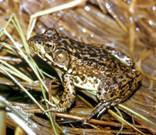|
"Your gateway to
understanding |
Frogs

- Lifecycle is characterized by complete metamorphosis
- Tied to water (Oneida Lake) because of ‘shell-less’ eggs
- Of the eleven frog species in New York State, seven are common in Oneida Lake
Eleven frog species reside in New York State, but the most common around Oneida Lake are the: gray treefrog (Hyla versicolor), northern spring peeper (Pseudacris c. crucifer), bullfrog (Rana catesbeiana), green frog (Rana clamitans melanota), wood frog (Rana sylvatica), northern leopard frog (Rana pipiens), and the pickerel frog (Rana palustris).
Each frog species in New York begins life as an aquatic tadpole (center photo), possessing a tail but no limbs, and breathing underwater with internal gills. Many species metamorphose soon after hatching, but some tadpoles remain aquatic for months, or even years, until climatic conditions are suitable. The transition from tadpole to frog involves many physical changes, including the absorption of the gills and tail, an eyesight change to allow sight through air, the skin thickening to avoid drying out, and development of stronger limbs to support the body’s weight on land.
Frogs typically remain terrestrial as adults (right photo), but return to the water when sexual maturity has been reached to deposit their eggs (left photo). They have developed several ways of getting their eggs into water sources, including carrying eggs on their backs, and constructing foam nests on leaves where eggs can drop out into the water. Most species produce shell-less (amamniotic) eggs that must be deposited in the water because they rely on moisture from the surrounding water source. Amamniotic eggs are enclosed in a protective, gelatinous envelope (left photo). Tiny larvae (tadpoles) hatch from these translucent eggs, and are nourished for a short period by a yolk sac. From here, the tadpoles will continue the life cycle and will one day reproduce like their parents.
To learn more about Frogs ...
